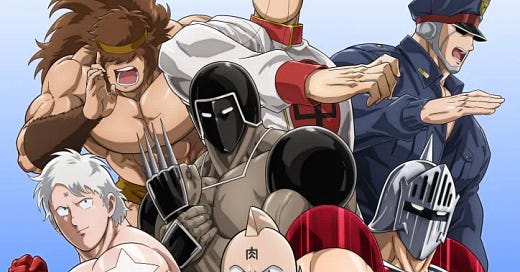A guide to Kinnikuman: The underrated and influential pro wrestling anime
Springs, toilets, and sneaker crocodiles, oh my!
WHAT IS KINNIKUMAN?
Kinnikuman is a manga first published in 1979 in the weekly shounen jump by the duo Yudetamago, who had been friends since high school when they created the character. Initially, it started as a parody of the giant-size superhero Ultraman, with the first few chapters and episodes focusing on the titular hero, who was mistakenly blasted off a ship by his father. The early story arc revolved around the hero battling giant monsters with lots of humor and hijinks until it shifted its focus to superhuman pro-wrestlers, introducing quirky characters like a living toilet, a man who could turn into a bike, and a giant steam roller made of sand. The series concluded after 300 chapters.
Over a decade later, a sequel named Kinnikuman Nisei was released, featuring a darker and more explicit tone, addressing subjects like child abuse and depression. This series followed the son of Suguru (Kinnikuman's real name), Mantaro, and the next generation of superhumans. This sequel was followed by another involving time travel and interaction between the two generations. A direct sequel to the original series came out in 2011 and is set to be adapted into an anime, which will premiere on Netflix on July 7th this year.
THE STORY ARCS
The series starts with the Kaiju Extermination Arc. It follows Suguru, his friend and sidekick from his home planet, Meat, as they fight giant monsters and the evil skeleton, Kinnosuke Man. This arc also introduces Kinnikuman's rival-turned-best friend, the American Terryman, along with Terry's reporter girlfriend, Natsuko, and the teacher, Mari, who is Kinnikuman's initial love interest. The story then moves on to the 20th Choujin Olympics, where the series becomes about pro wrestling and the antagonists-turned-allies, Robin Mask (who's British and Kinnikuman's main rival) and the character Ramenman (a martial artist who was so popular, he got his manga and anime). The arc concludes with Kinnikuman defeating Robin Mask.
After that is the America tour, an arc which follows Kinnikuman facing off the top Choujin of different states and being taught the 48 killer moves by the Hawaiian wrestler Prince Kameahamea and concludes with a brutal rematch against Robin Mask, which ends with his supposed death. What follows next is the Second Kaiju Extermination arc, which is a weird detour back to the Ultraman parody arc and is skipped in the anime. The most notable thing is the introduction of Biniba, the main love interest of the series and the princess of a rival alien clan.
Next is the 21st Choujin Olympics, which introduces the prominent cast members Brockenn, Wolfman, a sumo wrestler, and Warsman, a Soviet cyborg soldier and my personal favorite of the cast. Highlights of this arc include Warsman drinking tea from the head of a living teacup and Kinnikuman fighting a urinal, along with the surprise return of Robin Mask.
This is directly followed by the 7 Devil Choujin and 6 Devil Knights arcs, where the body of Meat is split into seven pieces so the collective group of heroes, now called the Justice Choujin, fight devil worshipers who want to resurrect their master and are led by Buffaloman, who later joins the main cast after his defeat. The 6 Devil Knights arc is the battle against the elite forces of the devil and ends with a struggle against Akuma Shogun, who at first is implied to be Satan but is then retconned later to be another follower.
These two arcs are probably the highlights of the series, in my opinion. They feature some of the series’ most creative characters and fights, along with moving scenes and moments of camaraderie between the main cast. They also introduce the final central cast member, Geronimo, an ordinary Cherokee man who pretends to be a Choujin. Highlights include Planetman, a guy made up of a miniature solar system with a sun inside, Cassetking, who can rewind and fast-forward time, and Blackhole, a being that absorbs anything that touches him.
Next is the penultimate arc, the Dream Tag Tournament, a tag-team wrestling arc featuring two surviving Devil Choujin who use a box to steal friendship from the heroes, causing infighting. The main threat in this arc is the perfect Choujin Big the Budo and Neptuneman, who resembles a masked Hulk Hogan. This is followed by the Scramble for the Throne arc, the longest and final arc with highs and lows. The most exciting part of the series is the Throne arc, which is a mixed bag. It revolves around five evil gods who do not want Kinnikuman to become king. They reveal five other orphans from the same planet who landed on Earth and participated in a fight to determine the rightful heir in a survival tournament.
THE INFLUNCE OF KINNIKUMAN
This series has inspired many manga and anime series, such as Fairy Tail, Fullmetal Alchemist, Yu Yu Hakusho, Naruto, One Piece, and Assassination Classroom. The series has sold 77 million copies in Japan and spawned a trendy toy line brought to North America called M.U.S.C.L.E. In wrestling, the Muscle Buster was utilized by several wrestlers, including former AEW and TNA champion Samoa Joe, among many others.
IN CONCLUSION
Kinnikuman is a wacky yet somewhat dated series that I enjoy. Still, it includes some problematic elements of old pro wrestling and old media in general, such as racism and misogyny. However, as the series progresses, it mainly sheds these elements. Despite knowing little about the creator's views, Yudetamago has evolved. I highly recommend the original series and its sequel, as well as the upcoming new anime on Netflix, which will be released worldwide on July 7th. I hope this information is helpful to anyone interested in watching the latest anime.





